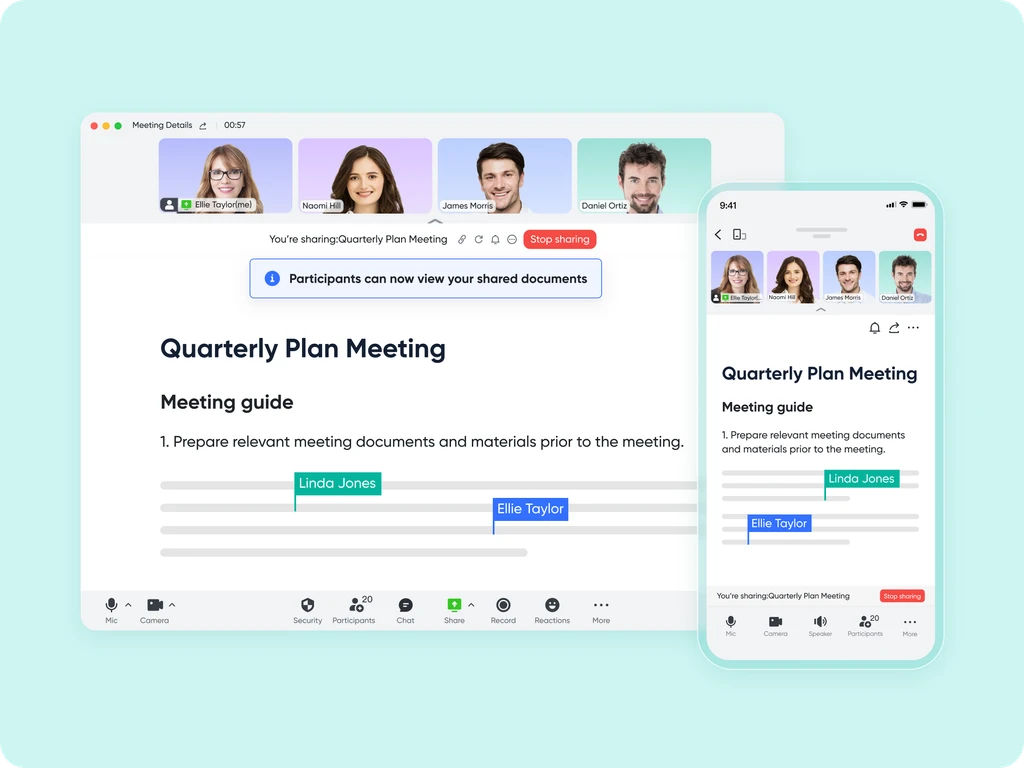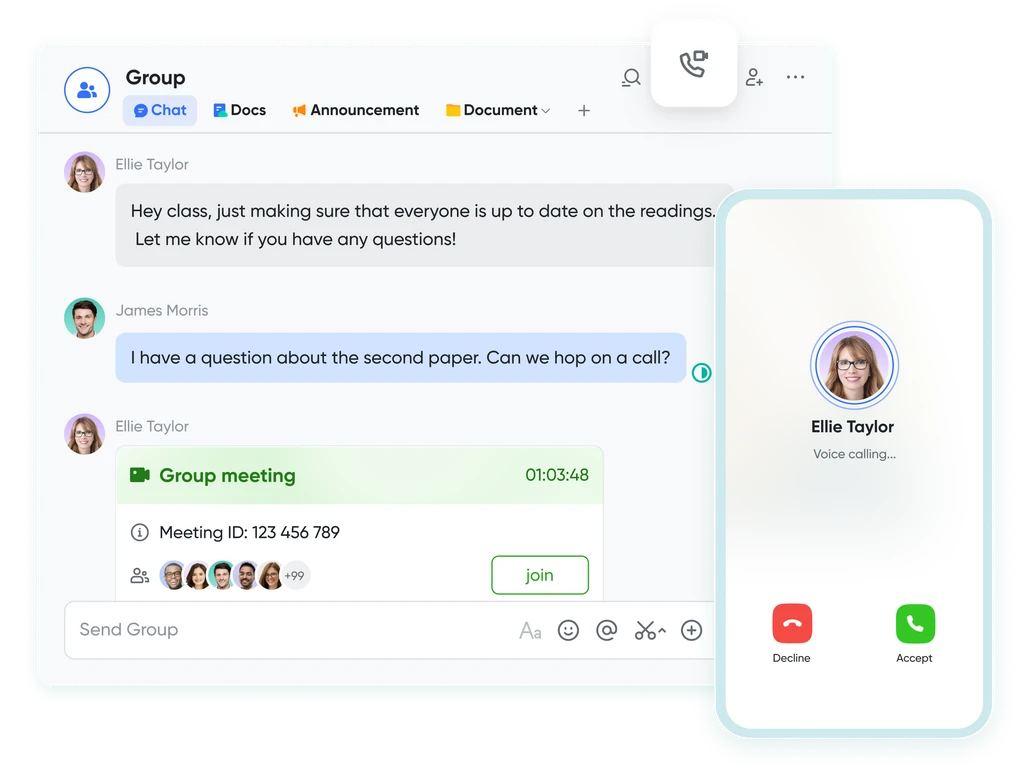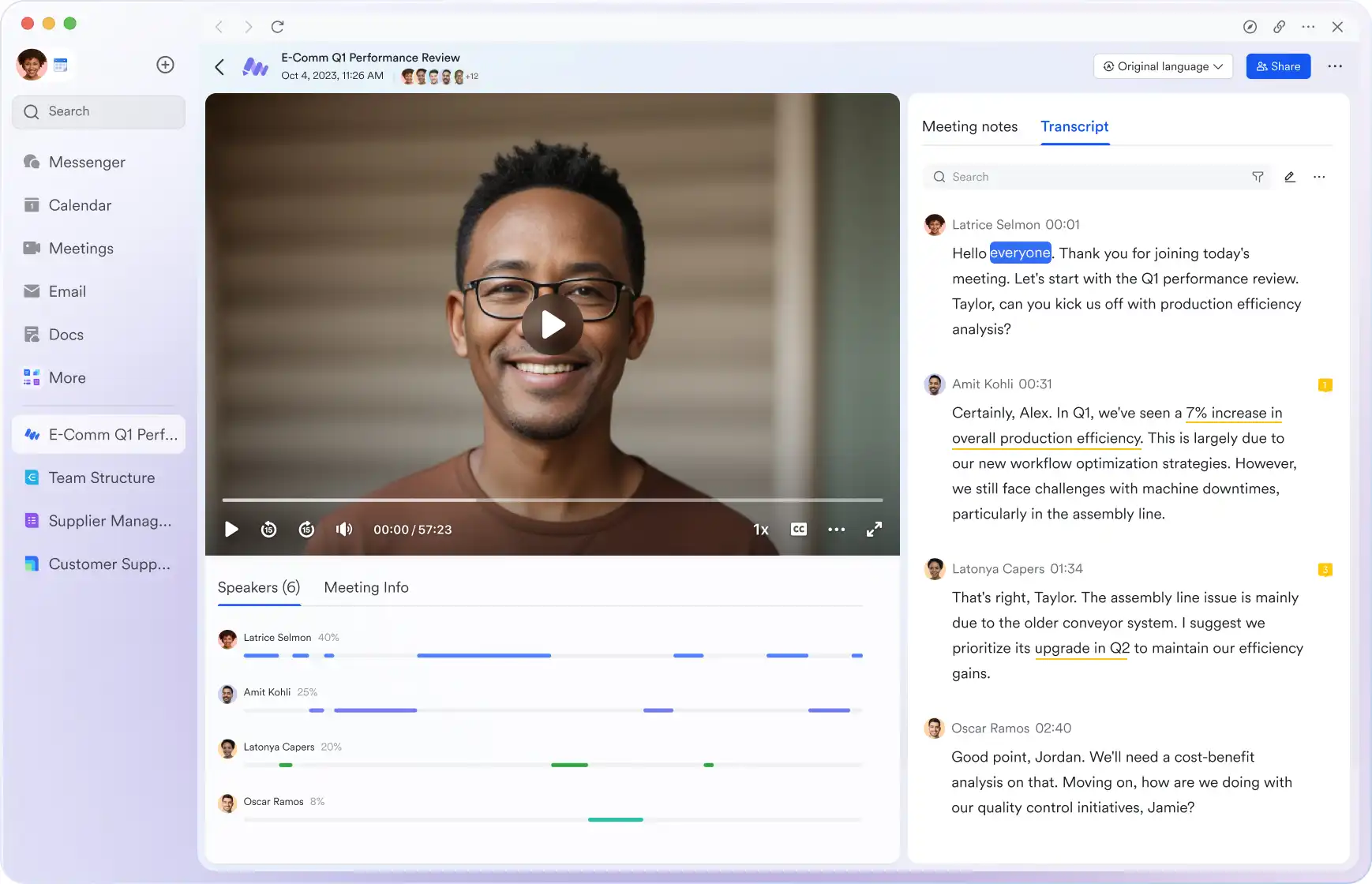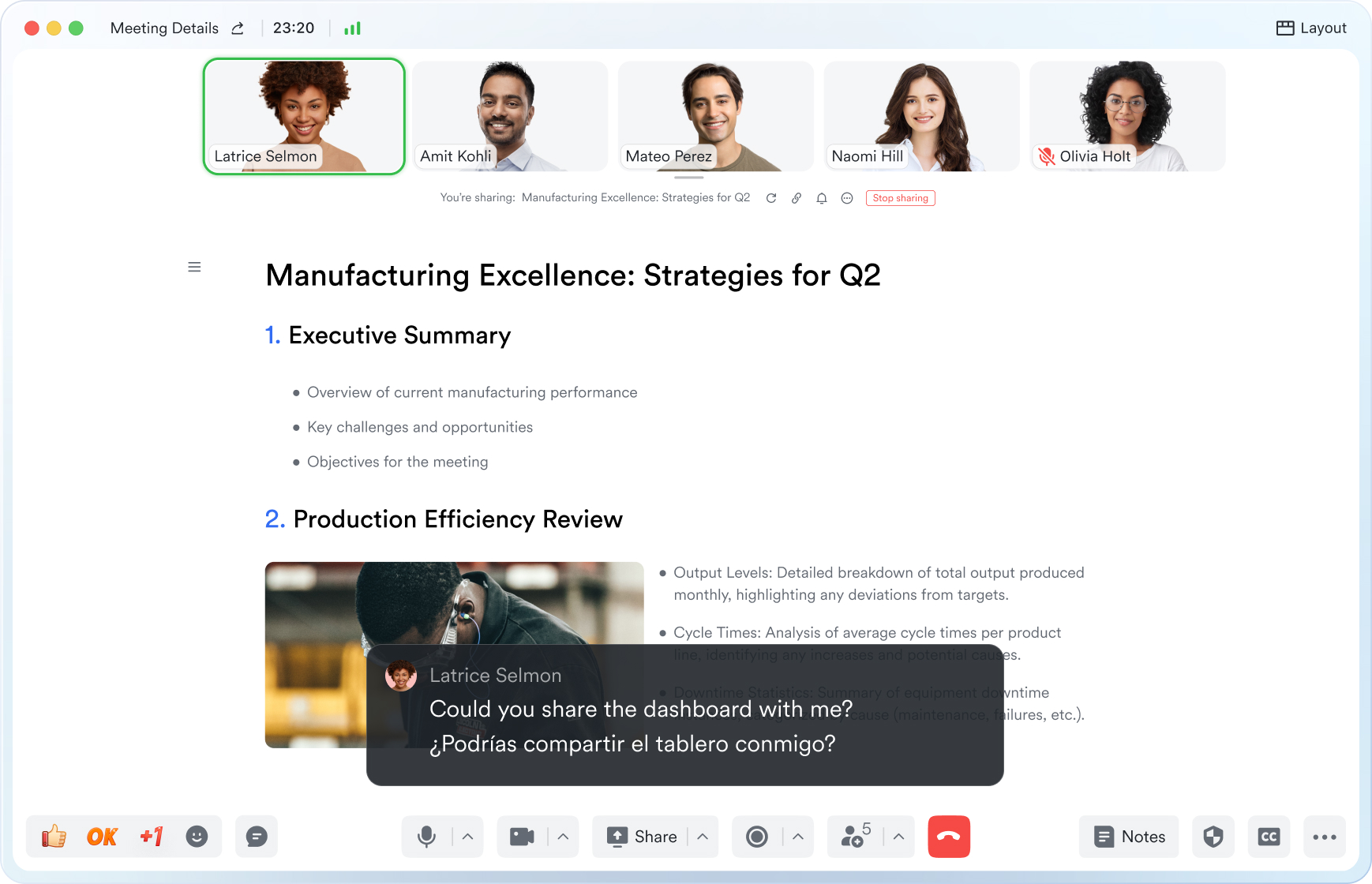Training Meeting
This guide will walk you through the essential elements of use training meeting to keep your attendees aligned and engaged.
Try Lark for Free
In today's dynamic business landscape, the proficiency of training meetings plays a pivotal role in nurturing a knowledgeable and skilled workforce. Whether it's employee induction, skill enhancement, or knowledge dissemination, a well-organized and effective training meeting can significantly impact an organization's success. This comprehensive guide aims to equip professionals with the essential knowledge and strategies to host successful training meetings in 2024. From understanding the core principles to implementing best practices, this guide will delve into the intricate details of running effective training meetings.
Use Lark Meetings to turn meetings into true collaborative experiences.
What is a training meeting?
A training meeting serves as a platform for transferring knowledge, cultivating skills, and aligning employees with the organization's objectives. It is a designated gathering where individuals come together to acquire new information, develop competencies, and participate in interactive learning experiences. The primary purpose of a training meeting is to facilitate the exchange of knowledge and skillsets that contribute to individual and organizational growth.
Goals of training meeting
The key goals of a training meeting encompass:
- Facilitating a comprehensive understanding of new processes, technologies, or industry standards
- Enhancing specific skill sets that are essential for professional roles
- Aligning the team with organizational culture, values, and goals
- Encouraging active participation and engagement to foster a culture of continuous learning
Who should attend training meetings?
The ideal participants for a training meeting may vary based on the meeting's objectives and content. The primary stakeholders and participants include:
- New hires: To provide foundational knowledge and integrate them into the organizational ecosystem.
- Mid-level employees: To enhance specific job-related competencies or explore leadership development opportunities.
- Leadership teams: To align them with strategic initiatives, cultural imperatives, and significant changes within the organization.
Learn more about Lark x Meetings
Topics, agenda, and structure of training meeting
Selecting Relevant Topics
The agenda of a training meeting should focus on topics that address specific learning objectives or organizational needs. It should cater to the existing knowledge base and the requirements of the participants.
Structuring the Agenda
The structure of the training meeting should include a clear breakdown of topics, interactive segments, and allocated time slots for each component. It should emphasize the importance of engaging and informative sessions.
Creating an Engaging Format
Implementing diverse formats such as presentations, group discussions, workshops, and role-play activities can ensure that the meeting remains engaging and contributes to active learning.
Learn more about Lark x Meetings
How often does a training meeting occur?
The frequency of training meetings can vary depending on various factors, including:
- Organizational needs and priorities
- Nature of the content and the rate of change in the industry
- Availability and schedules of the participants
A balanced approach that aligns with the need for constant learning and practical constraints should determine the frequency of training meetings.
Key differences between training meetings and similar meetings
Training Meetings vs. Team Briefings
While training meetings focus on imparting new knowledge and skills, team briefings primarily serve to update the team on organizational developments and task-related information.
Training Meetings vs. Workshops
Workshops are hands-on learning sessions that emphasize practical skill development, whereas training meetings encompass a broader array of knowledge dissemination and skill enhancement.
Training Meetings vs. Seminars
Seminars are typically lecture-style presentations aimed at sharing expertise on specific topics, whereas training meetings incorporate interactive elements and engagement strategies to facilitate an immersive learning experience.
Learn more about Lark x Meetings
Three practical examples of training meetings
New hire orientation program
New hire orientation program
The orientation session provides essential information about the organization, its culture, policies, and expectations. It also introduces new hires to key members of the team, facilitating a smoother transition into the organization.
Sales training workshop
Sales training workshop
The sales training workshop focuses on enhancing the selling skills and product knowledge of the sales team. It includes role-playing exercises, case studies, and interactive sessions to maximize engagement and learning.
Diversity and inclusion training
Diversity and inclusion training
This training meeting aims to foster an inclusive workplace culture. It addresses topics such as unconscious bias, cultural competency, and effective communication across diverse teams.
Common pitfalls of training meetings
Lack of Clear Objectives
When the goals and objectives of a training meeting are ambiguous, it can result in disengagement and a lack of direction among the participants.
Overloading with Information
An excessive amount of information conveyed in a single session can overwhelm participants, leading to lowered retention and effectiveness of the meeting.
Ineffective Delivery
Poor presentation skills or a monotonous delivery style can hinder participant engagement and compromise the meeting's impact.
Learn more about Lark x Meetings
Dos and don'ts of training meetings
| Do's | Don'ts |
|---|---|
| Encourage open discussions and questions | Avoid using complex jargon without clarification |
| Use interactive materials and visual aids | Rely solely on traditional lecture-style presentations |
| Provide actionable takeaways and resources | Overwhelm participants with excessive information |
| Incorporate real-life examples and scenarios | Disregard participant feedback and suggestions |
What makes a virtual training meeting successful?
In the digital age, virtual training meetings require specific strategies and considerations to ensure their efficacy, including:
- Utilizing interactive platforms and tools to maintain engagement
- Adapting content to suit the virtual environment, incorporating multimedia and interactive elements to enhance learning
- Providing clear instructions for accessing and utilizing virtual resources
Learn more about Lark x Meetings
Typical takeaways of the training meeting
Participants can expect to gain the following takeaways from a successful training meeting:
- Enhanced knowledge related to the designated topic or subject matter
- Acquired skills, strategies, or methodologies relevant to their roles or responsibilities
- Valuable insights and actionable practices to apply in their professional endeavors
Questions to ask in the training meeting
Open-Ended Questions
- How can the material covered in the meeting be applied in your daily work tasks?
- What aspects of the training session did you find most valuable, and why?
Reflective Questions
- In what ways do you anticipate applying the new information or skills gained from this training meeting?
- How do you think this training session will contribute to your professional growth within the organization?
In conclusion, hosting an effective training meeting is a multifaceted endeavor that demands meticulous planning, engaging delivery, and diligent follow-up. By adhering to the best practices and strategies outlined in this guide, professionals can create an environment where knowledge is not just shared but comprehended, absorbed, and aptly applied. This comprehensive guide aims to empower individuals with the expertise to orchestrate successful training meetings that foster continuous learning, skill enhancement, and organizational alignment.
Learn more about Lark x Meetings
Use Lark Meetings to turn meetings into true collaborative experiences.
A Game Changer for Training Meeting: Empower your team with Lark Meetings
In the fast-paced and dynamic world of modern business, effective communication and collaboration are crucial for success of Training Meeting. Here we introduce Lark Meetings to serve as a centralized hub for all communication needs.
Transform your meetings into collaborative endeavors

Leverage the potency of in-call document sharing, intelligent meeting minutes, and mobile-optimized features to enhance productivity collaboratively, irrespective of your location or schedule.
Seamlessly collaborate in real-time, across any device

Share live documents instead of just screen views. Participants can navigate and edit simultaneously within the video call window, even while on the move.
Shift your focus to engagement, not note-taking

Lark Minutes automatically converts video meetings into transcripts, facilitating easy viewing, searching, and collaborative editing. Stay in the loop asynchronously, even if you can't attend the live meeting. Lark Minutes for meeting minutes support translation into 10+ different languages.
Break language barriers in communication

Lark Meetings provide real-time translation for subtitles, allowing individuals from diverse backgrounds to express themselves in their native languages. Ensure every voice is heard, regardless of geographical location. Live subtitles currently support translations from English, Chinese, and Japanese to 10+ different languages. See more translation feature in Lark.
Connect with larger audiences
Host dynamic online meetings and events accommodating up to 1,000 participants, with the flexibility of up to 50 breakout sessions for intimate group discussions within the larger meeting context. Try more Lark features for free.








